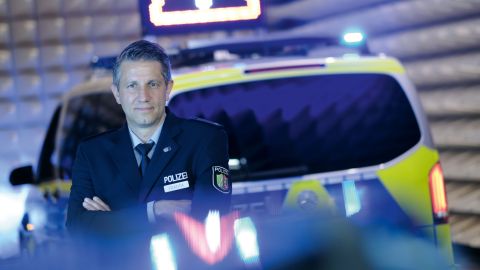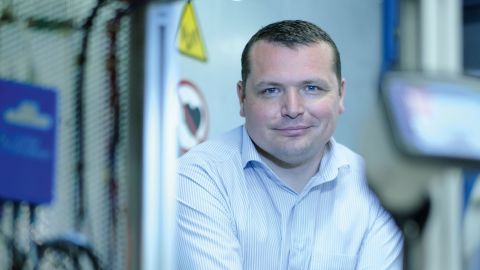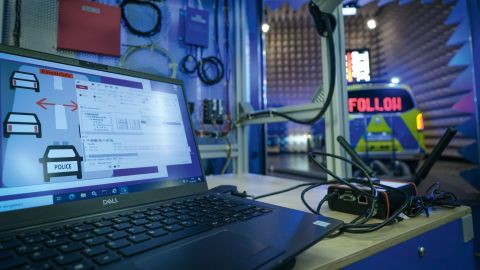In the past, when we only dealt with vehicle technology, our colleagues spoke - not always respectfully - of the "oil and grease department". But the analog times are over. "We want the needs of the police to be taken into account as early as the production of networked vehicles," explains Police Councillor Franta. Since October 2020, sub-department 31.4 has taken on the task of coordinating all police efforts in this area.
Franta considers narrow departmental thinking to be outdated. Automotive IT (AIT) must be seen as a joint challenge. "If we want to benefit from the rapid development in this sector, the various areas of the police must work together to develop concepts and ideas. Then we will be on the right track." The newly created sub-department is something like the spearhead - a kind of think tank.
In the course of his police career, the 44-year-old rock music fan has become increasingly involved with technical issues and wrote his master's thesis at the German Police University in Münster on the subject of "Automated Driving". Franta, who was born in the Czech Republic and grew up in Unna, finds it "very exciting" to help specify future police requirements for vehicles. In addition to police officers, it is engineers and other technicians who are testing ideas and models and making suggestions in Duisburg.
There is enough need for action. From next year, the European Union will require the installation of certain driver assistance systems in newly registered cars.
"As police, however, we have to disregard traffic regulations in certain situations, for example when pursuing a suspect or when driving on a special route or right of way," explains Franta. "Automatic braking would be counterproductive."
At the same time, according to the official, the aim is to optimize accident investigations. For example, control units in vehicles already record data from the period shortly before, during and immediately after a collision. However, the data cannot be read by the police in all cases, which can have various reasons.
Franta hopes that the car industry will create the conditions to be able to retrieve accident data from all cars without any problems. Even criminal cases could be solved in a more targeted manner. Because alleged accidents can also conceal homicides. The Event Data Recorder (EDR) stores the events. If no attempt has even been made to swerve or brake, this is stored.
The North Rhine-Westphalia police are in close dialog with politics, business and research. Since 2021, it has been an associate member of the KoMo:D next cooperation network, the Cooperative Test Field for Mobility in Düsseldorf. This is a project that aims to further advance automated driving. Partners include the Düsseldorf traffic control center, RWTH Aachen University, the German Aerospace Center and the companies Vodafone, Siemens, ZF Friedrichshafen and Swarco with their mobility and digital expertise. It is about the electronic communication of the technology installed in the car with traffic lights and other roadside units (RSU). Under the acronym V2I (Vehicle to Infrastructure), tests are being carried out on how vehicles can best be coordinated with the digital traffic infrastructure.
"We are proud to be at the forefront here," says Franta. "The collaboration is unique in Germany." The father of three explains what has become feasible: "For example, if we switch on the blue lights and siren, a signal could automatically go out to a traffic control center and locally to the traffic lights, which are switched to green for the operation."
In the computer-equipped laboratory rooms under the LZPD NRW, the head of 31.4 points like Tüftler Q in a James Bond film to a police control vehicle with electronic warnings for drivers. "It could transmit warnings to the displays of citizens and patrol cars at an early stage."
Alexander Weinberger is standing next to Franta. The 34-year-old engineer is developing software so that V2I technology can be used in radio patrol cars. He applied for the job advertisement for the reorganization of the sub-department and has been there since August. "We are the pioneers here. It would make sense to equip the entire police fleet in this way at some point," he says.
But there are still details to be worked out. For example, it needs to be clarified how a traffic light system has to be designed so that it can receive and transmit the corresponding signals. The vehicle technology graduate believes that many things are feasible in principle: "We are building the mobility of the future." Autonomous driving will also be part of this one day.
It all still sounds a bit like science fiction. Thomas Franta knows that too. "Many legal and political issues are still unresolved." But that's not what his team is working on. "We first want to create the conditions so that we can decide on the right path later."


